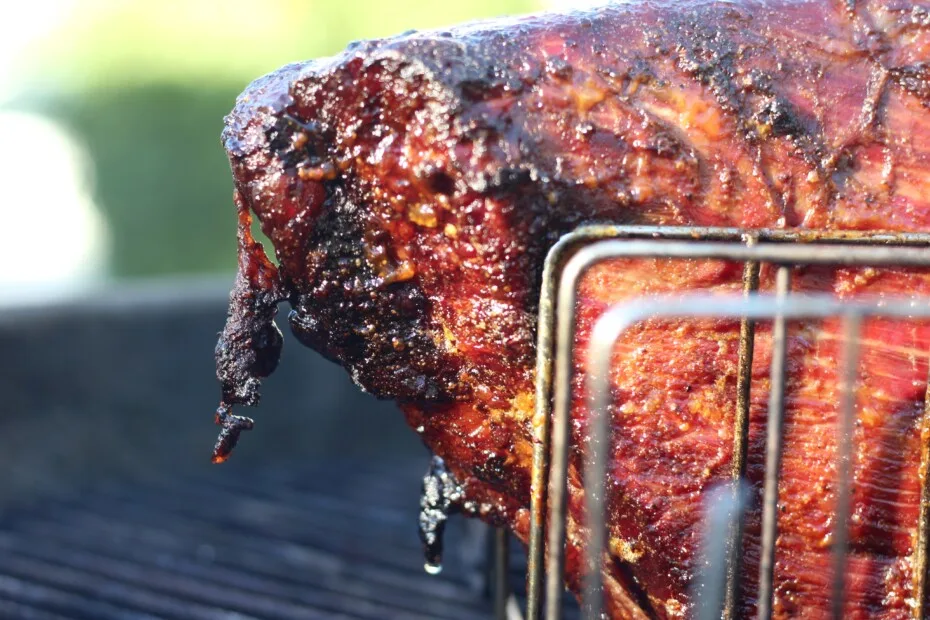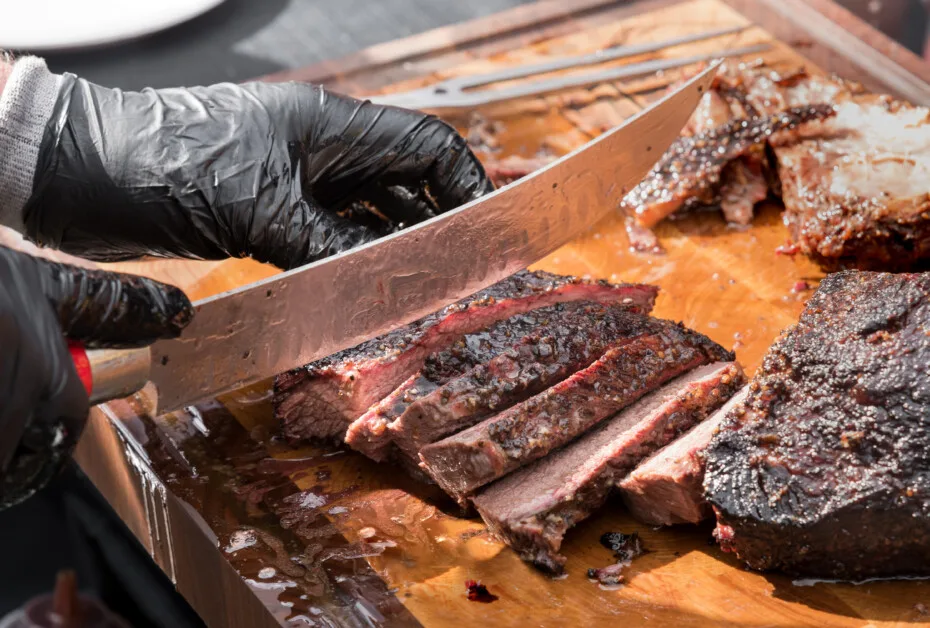Humans seem to make an argument out of everything, even meat. But, alas, some subjects of contention in the BBQ arena have never been solved.
Brisket fat side up or down is a prime example of one of the debates that have never been resolved.
If you are just entering the BBQ world, this may be one of the pressing questions you are too afraid to ask BBQ experts.
You may be confused by all of the contradicting opinions on the world wide web that never provide you with a clear answer.
However, we are unpack this argument in great detail.
Contents
What’s the Nature of the Debate?
A brisket has two different sides. One side has a layer of fat, while the other side is pure protein.
Besides the polar opposite sides of the brisket, they consist of two different muscles: the point and flat.
A thicker layer of fat covers the point while a thin layer of fat sits on top of the flat.
BBQ aficionados may cut their brisket in half before cooking it. However, for best results, brisket should be left whole.
Nevertheless, the critical subject of discussion is whether the fat should be left up or down.
What Factors Determine Fat Side up or Down?
The factor that determines whether you should place a brisket up or down is where the source of heat is located in the cooker.
Most cookers are manufactured to have the origin of the heat on the bottom. Thus, you should place your brisket fat side down.
However, there are exceptions to the rule. Case in point, horizontal offset smokers are designed with a heating chamber situated at the top of the machine.
In this instance, you should place the brisket fat side up. The layer of fat acts as a built-in insulation unit.
It protects the meat from heat produced from the top of the machine.
If you do place your brisket fat side down, make sure you check the lean side of the brisket every so often to ensure it is not drying out.
One way to prevent your meat from drying out is to wrap it in butcher paper or foil halfway through the cooking process.
Be sure you inspect your cooker thoroughly to find the source of heat.
This will help you greatly when deciding if you should place your brisket fat side up or down.

Cons of Brisket Fat Side Up
Many people are duped into placing their brisket fat side up because of a myth.
The thought process behind the fat side-up theory is the fat cap melts and braises the brisket. Therefore, the fat infuses or melts into the brisket and promotes moisture.
However, this is a myth. Have you ever heard that saying oil and water don’t mix? The same is true for BBQ.
Brisket contains both oil and water, and they should never be mixed.
A brisket has oil in the fat cap and water in the lean red meat. Thus, fat can’t penetrate the meat and promote moisture.
The second component of this theory is that fat is responsible for tenderizing the meat. However, this is not true.
Fat does not tenderize brisket. The breakdown of collagen does. Collagen or connective tissues in the meat are responsible for holding the brisket together.
Cooking the brisket for extended periods creates the perfect environment as well as gives the collagen ample time to break down.
Thus, tenderizing the brisket.
Bottom line cooking brisket fat side up will braise or tenderize meat.
Additionally, cooking the brisket fat side up poses a big threat to the flavor of the brisket.
Cooking the brisket fat side up erases the seasonings. The fat will melt and run down the surface of the meat carrying away a sizeable portion of the seasonings.
The seasoning will wind up in the grease pan or in the fire, not on the brisket. Ultimately, your seasoning will be in vain.
Another con of cooking brisket fat side up is the presentation. We all know in the world of food, presentation is everything.
The bark is the brisket’s focal point. It is a delicious, deeply colored crust that develops on the outside of the meat.
The bark is attributed to a series of chemical reactions. The rub you used to season the brisket, protein, and the smoke from the meat are responsible for the bark.
Benefits Of Cooking Brisket Fat-side Down
Cooking a brisket, the fat side down, has many benefits. Cooking brisket fat side down has many advantages, including the uniform development of the bark and keeping the seasoning in its rightful place. On the brisket and not in a grease pan.
As we have stated earlier, if the heat originates from the bottom of the cooker, cooking it fat side down will protect the meat from guards the meat from the rigid heat.
Heat traveling above the brisket is responsible for the loss of moisture.
The brisket’s fat cap acts as a protective barrier keeping the heat of the intense flames at bay and minimizing moisture loss.
Furthermore, cooking brisket fat side down allows droplets of fat to drop into the flame and generate more smoke.
In this case, the more smoke is a good thing. It will infuse into the brisket and produce a greater depth of flavor.
However, if white smoke appears, tread carefully. A small amount of white smoke is okay. Excessive amounts of white smoke will destroy the brisket s flavor.
Allows You To Mop the Brisket
Many pitmasters apply a mopping sauce to their brisket. A mopping sauce is a thin watery solution used to continuously baste brisket and add extra flavor while it is cooking.
It is applied with a brush that resembles a miniature mop or placed into a bottle and spritzed on the brisket.
Mopping the meat has numerous benefits, including sealing in moisture during the beginning stages of cooking.
It also builds layers of flavors and aids the development of the bark in the latter half of the cooking process.
Best of all, you get to look at your brisket several times before it’s finished cooking.
If you are cooling the brisket fat side up, you will not be able to mop or spritz the meat. At the same time, you can baste the fat with the sauce. But it serves no purpose as it will run right off into the greased pan.
Gives the Brisket More Meat Exposure
The secret that remains largely undiscovered by most seasoned BBQ experts is the 30% rule.
Cooking brisket fat side up makes the meat subject to contact with the grates. Yes, the gaps in the grate do permit smoke travel to the brisket, but the portions that are positioned directly onto the grates do not receive the smokey flavor.
The standard cooking grate’s surface area is approximately 70% open and 30% close due to the rods used to construct the grate.
Cooking it fat side down exposes the meat by 30% allowing all of the meat to be exposed and infused with beautiful smokey flavor.
Cons of Cooking Brisket Fat Side Down
There is one drawback of cooking meat fat side down. Two types of heat circulate inside the smoker: heated air and radiant heat.
Heated air oscillates in the smoker nearly the entire cooking time.
On the other hand, radiant heat progresses in a straight line and heats anything it touches.
Radiant heat is responsible for drying brisket out. Hence most pitmasters never allow radiant to come into direct contact with brisket.
What if I Have an Offset Smoker?
If you own an offset smoker, there’s honestly no need to worry about it. Yes, you will have to cook your brisket fat side up, but you don’t have to worry cons of cooking a brisket fat side up.
There are a few simple solutions that will minimize the damage.
The main thing you can do to prevent it from destroying the bark is to wrap it with butcher paper or foil.
Though we recommend using pink butcher paper or each butcher paper as it is affectionately called.
Should You Flip Brisket When Smoking?
Flipping the brisket levels out the exposure of the meat to the heat. Place your meat fat side down on into your smoker.
Flip the brisket fat side up midway through the cooking process.
This simple technique promotes the even formation of the bark. It also allows the spice rub to really penetrate the brisket.
You can also do this flipping process in reverse!
However, if you place it fat side up first, there is still the chance that the brisket’s aesthetic side and the rub will stick to the grates or wash away.
Cooking brisket fat side down in an offset smoker only leaves the meat defenseless for half the cooking time.
Nevertheless, you can always use butcher paper or foil for added protection.
Nonetheless, there is an advantage of flipping brisket over. If you turn your brisket over every two hours or so, basting it with a mop sauce creates a middle ground.
Those who subscribe to the fat side up theory believe the flipping the meat allows it to rest and soak up more moisture.
As a result, one portion of the brisket will not dry out, and the other will be basted with the melting fat.
Unfortunately, most advantages do not come without a drawback. Each time you turn your brisket over, pockets of moisture pool on the surface of the meat.
Those droplets of moisture will drop onto the flame, causing an excess of smoke.
In addition to this water has weight. Every time moisture collects, it places tension on the meat, which causes it to release even more moisture.
Luckily mopping or spritzing the brisket every time you flip it remedies the moisture loss.
Another con of this middle ground method is the action of turning the meat may cause tears in the fat. Tears in the fat; equal loss of moisture.
Carefully turn your brisket to prevent the fat from tearing, or you will end up with a hunk of dried-out meat.
Final Thoughts
Brisket: fat side up or fat side down is the question of the day. We say fat side down. However, if you must cook your brisket fat side-up, be sure to proceed with caution.
You might also be interested in the following:
- Do You Cook Pork Butt Fat up or Down?
- Do You Cook Salmon Skin up or Down?
- Do You Cook Turkey Breast up or Down?
- Pork Shoulder Fat up or Down?
- Corned Beef Fat Side up or Down?
- Do You Use Aluminum Foil Shiny Side up or Down?

I have been smoking and grilling meat from an early age and enjoy sharing my knowledge and expertise through the hundreds of articles I have written about BBQ. I hope to make everyone’s BBQ journey that little bit easier.

